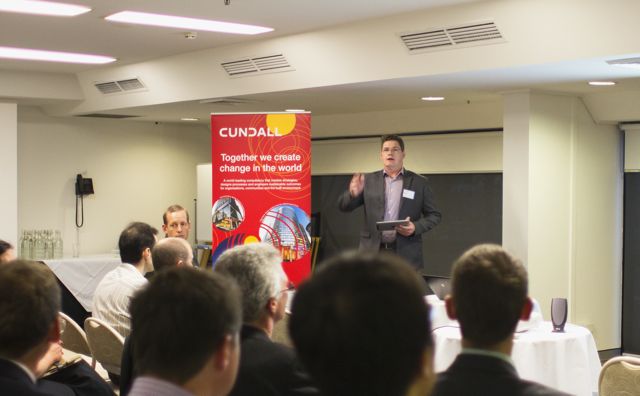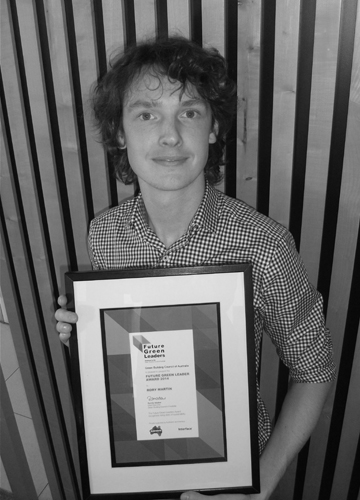 |
| Carbon balloons for World Green Building Week |
While the world takes a deep dive into uncertain territory, especially on climate issues and especially in Australia, the world of green buildings moves inexorably onwards.
For World Green Building week concluding Friday the focus broadened from buildings and owners to tenants, emerging stars and now the concept of positive development through social outcomes.
At 50 Bridge Street in Sydney, AMP Capital did some “gamification” with tenants to drive home some key messages on carbon consumption and savings using balloons, lollies in giant jars and guessing competitions.
According to national sustainability manager for AMP Capital, Dominic Ambriano, the exercise played into the company’s Building Connections program designed to engage tenants in “nodes” of focus such as sustainability, health and well-being.
- See Chapter 8 of the Tenants and Landlords Guide to Happiness for more on this.
Put that way, tenants can see for themselves that the common refrain that buildings are a powerful way to save greenhouse emissions (and money) just might have the ring of truth to it. The guessing game was for how many balloons exactly were displayed (here’s a hint, it’s somewhere in the 300 mark) and winners will be announced next week.
The exercise was repeated with about 10 other major buildings owned by AMP throughout the country including the huge Collins Place in Melbourne, while smaller buildings had signs displayed in the foyer and large jars with lollies to symbolise the carbon count
With the “gamification” the idea is simple - to “get people’s attention”, Mr Ambriano said. “Tenants are invited to try to count the balloons [or lollies] and we present information on energy to try to make it more meaningful.”
There’s also an implied message that while owners have been slashing the carbon production of their buildings, tenants have been lagging.
With building energy use split roughly 50:50 between base building and tenancies the savings by owners means the scales are tipping - negatively - towards tenants in terms of carbon produced.
Mr Ambriano said that the environmental node in the tenant engagement program is probably the easiest to get across because people are hearing the message on environment from so many sources and because there is money to be saved from energy efficiency.
“It’s been difficult in the past but we’re making breakthroughs and that’s because of the building connections program.”
As revealed in the “Happiness” book, the tough part is encouraging tenants to share their electricity billing data, which, as owners know, is the start of reform, exemplified in the old adage, “you can’t manage what you don’t measure”.
Having fun helps, so the gamification of the program has extended to the company’s “floor wars”, which pits one floor of tenants against another to save the most energy.
Green leases are emerging, he said, but there are still “a good percentage” of properties not subject to green leases where more information and collaboration can yield the right results.

Cundall’s David Collins Introducing the evening
Impact development
Cundall chose impact development as the theme for 10 events it held world wide as its contribution to World Green Building Week this year.
Impact development
Cundall chose impact development as the theme for 10 events it held world wide as its contribution to World Green Building Week this year.
“Traditional sustainability and environmentally sustainable development is not enough”, the company said in a promotional statement. “The property industry is looking to the next wave of innovation.” Instead of limiting negative outcomes the push is on for regenerative development, positive impacts and an urban environment that “gives something back”.
Right on cue the company has launched a consulting service to do just that, called Impact Development.
About 30 people attended the event this week which was likewise designed to have a positive social impact. The venue was Y Hotel, the former YWCA hostel next to Hyde Park in the city.
Profits from the event were directed to the YWCA, music was provided by a social charity called Music Makes a Difference which aims to help children with confidence issues,and art on the wall was provided by Alan Streets who has used art as a pathway to recover from drug and alcohol abused which initiated from struggling with paranoid schizophrenia.
Host for the night was principal Alistair Coulstock, who took over from Simon Wild who is soon to join Lend Lease.

Rory Martin
Future Green Leader
On the personal front Rory Martin, national sustainability leader with dwp|suters, was named the inaugural Future Green Leader.
Future Green Leader
On the personal front Rory Martin, national sustainability leader with dwp|suters, was named the inaugural Future Green Leader.
The judging panel for this inaugural award from the Green Building Council of Australia was impressed with “the depth of Rory’s experience and commitment to buildings that respond to their climate, are economic anchors, aesthetically appealing and healthy places for people” a statement from the panel said.
Mr Martin who handles strategic planning, environmental modelling, design reviews, policy development and marketing says his passion for sustainability started when he was a student and has driven his professional development in the 10 years since.
Chief executive of dwp|suters Leone Lorrimer said Mr Martin had helped embed sustainability into the company and “further woven sustainable thinking into the fabric of our design thinking”.
No comments:
Post a Comment